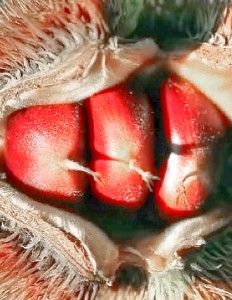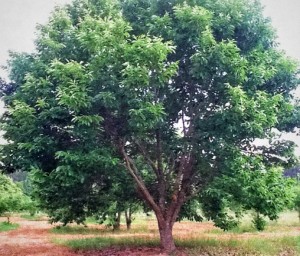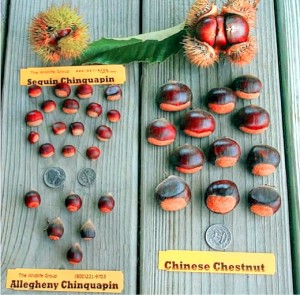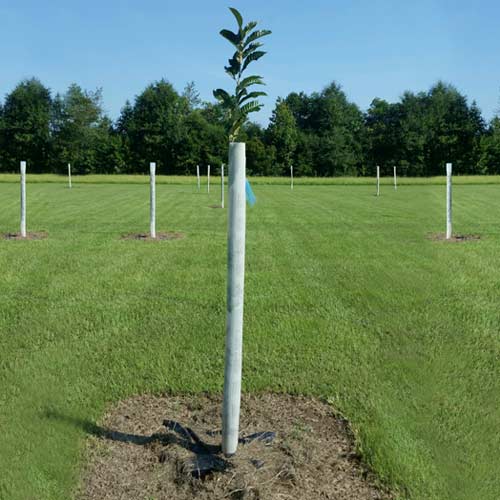 The American Chestnut once ranged from North Florida to Main and west to the Ohio Valley and was one of if not the most important trees in the eastern United States. These trees provided strong wood for fence posts, furniture, homes and many other uses. The chestnuts themselves were also a very important food source for humans and livestock, as well as wildlife. The American Chestnut was at the very center of the way of life in early America.
The American Chestnut once ranged from North Florida to Main and west to the Ohio Valley and was one of if not the most important trees in the eastern United States. These trees provided strong wood for fence posts, furniture, homes and many other uses. The chestnuts themselves were also a very important food source for humans and livestock, as well as wildlife. The American Chestnut was at the very center of the way of life in early America.
In 1904 the chestnut blight (Chryphonectria parasitica) was introduced to the U.S by mear coincidence. Asian Chestnuts were brought here for a project at the Bronx Zoological Park in New York City. By 1940 the blight had spread throughout the entire range of the American Chestnut, slowly destroying the once beautiful and bountiful forests and changing the eastern forest forever. The American Chestnut had matured and thrived in a blight-free environment and had never built any immunity to the fungus. Once introduced to the native range of the great trees it moved at a staggering pace, wiping out the eastern forest.
 So here we are today talking about the return of the American Chestnut. Landowners and land managers are always seeking new ways to attract deer and other wildlife but who would’ve thought that a four legged critter could cause such a stir? But that’s all you hear or read about lately in various hunting magazines and mentioned on many hunting shows. Everyone is talking about planting chestnuts these days. What’s all the rage and is planting them worth your time and money? I’ll let you decide. Here are a few facts for your consideration:
So here we are today talking about the return of the American Chestnut. Landowners and land managers are always seeking new ways to attract deer and other wildlife but who would’ve thought that a four legged critter could cause such a stir? But that’s all you hear or read about lately in various hunting magazines and mentioned on many hunting shows. Everyone is talking about planting chestnuts these days. What’s all the rage and is planting them worth your time and money? I’ll let you decide. Here are a few facts for your consideration:
- Chestnuts are a high energy wildlife food source high in starch, sugar and low in fats.
- They produce every year, typically the fifth year after planting and sometimes sooner. How? They bloom late, typically in May when all frost dates have passed.
- Most are huge producers. Those that are not huge producers produce larger chestnuts.
- Nearly all wildlife, as well as humans, love chestnuts. But once the deer find them, good luck trying to harvest your fair share!
- Most, if not all chestnuts drop in September. So the theory that deer will walk through white oaks to eat chestnuts is a futile discussion. Or should I say it is for me because all the white oaks I’ve seen drop in late October /November. If you would like to test this theory plant some AU Buck III & IV.
- Chestnuts rot and dry out rapidly on the ground so huge numbers of nuts don’t mean they will be palatable longer into the season.
- Chestnuts prefer a well-drained upland soil with a Ph of 5.0-6.5
- The best conditions for nut production include a warm, long growing season and a relatively mild winter.
- Fertilization is important for young trees. Apply one pound of 10-10-10 fertilizer each spring, increasing the rate each year by a pound until 15 years of age.
- Contrary to some reports, chestnuts are not fast growers, typically taking two to three years to get well-rooted and to show some real signs of aggressive growth.
During this time it is normal to see some minor nut production. My advice would be to remove any burs the first couple of years to allow the tree to exert all of its energy into new root development and growth.
- Chestnuts naturally hybridize so crossing many varieties is beneficial. Seedling Chinese Chestnut trees do a great job of pollinating and will give other varieties an extended bloom. Improper pollination will mean fewer nuts and many under-developed nuts.
Below are a few of the different varieties of chestnuts commercially available:
- American Chestnut – Susceptible to blight, small sweet nuts
- Chinese Chestnut – Blight resistant, large-volume producers grown from seed. The nuts will vary in size and taste. 15 year old trees average 150 pounds of nuts. Drop date September through early October.
- European Chestnut – Susceptible to blight. Many cultivars are bland and bitter.
- Japanese Chestnut – Small and spreading, blight resistant, large poor tasting nuts.
- Dunstan Chestnut – Blight resistant, large nut but not a large volume pro- ducer. Stout growing tree with taller, more pronounced trunk. Timber value a plus. Drop date September through early October.
- AU Buck II – Blight resistant , heavy producer, large nut, grafted variety. Large crops annually. Drops mid-Sep- tember thru mid-October. In 2006, the original 15 year old AU Buck II tree produced 282 pounds of nuts.
- AU Buck III – Blight resistant, heavy crop annually, medium sized nut, grafted. Drop date late September through October.
- AU Buck IV – Blight resistant, large nut, medium producer, grafted. Latest droppping chestnut typically starting around October 10th and lasting well into November.

Several other cultivars are available. I have just touched on a few. Do yourself and the wildlife on your property a favor and plant some chestnuts this season. Also, I strongly urge everyone to visit www.acf.org and become a member of The American Chestnut Foundation. Restoring our native trees should be everyone’s top priority. So make that call today and help make a difference.
_________________________________________________
References:
University of Florida IFAS Extension
American Chestnut Foundation
W. Alfred Dozier, Jr.
U.S. Patent Office


